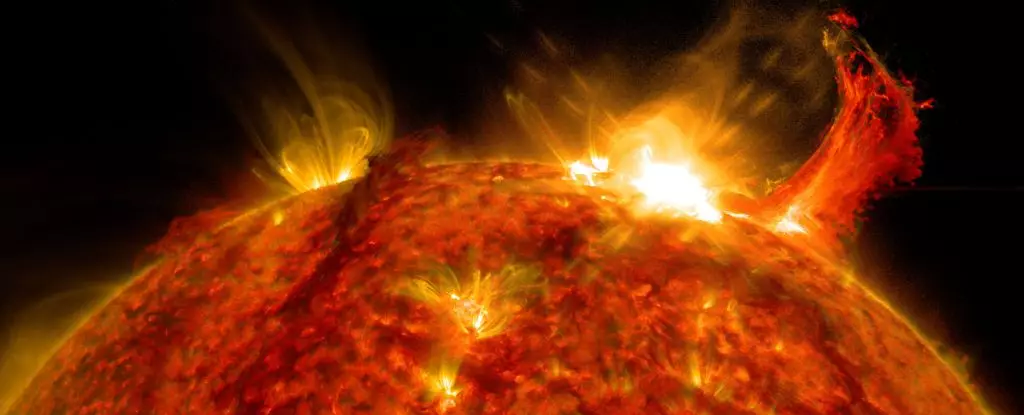In a fascinating exploration of our planet’s history, scientists have uncovered evidence of an extraordinary cosmic event that occurred approximately 14,300 years ago. The significance of this event, pegged at around 12,350 BCE, lies in its unprecedented intensity, signaling an ancient solar phenomenon that has left an indelible mark on Earth. Through the detailed examination of fossilized tree rings and ancient ice cores, researchers have pieced together a narrative that suggests a massive influx of particles from the Sun, constituting the most powerful geomagnetic storm recorded in history.
The study’s lead physicist, Kseniia Golubenko from the University of Oulu, highlighted the storm’s astounding magnitude—over 500 times more intense than the largest recorded solar storm of the modern era. Such intensity infers not just an anomaly; it presents a radical re-evaluation of our understanding of solar activity and its potential impacts on Earth.
The Science Behind the Storm
Geomagnetic storms are intricately linked to coronal mass ejections (CMEs), which are colossal expulsions of plasma from the Sun’s atmosphere. When directed towards Earth, these solar phenomena can induce a cascade of atmospheric disruptions. The most familiar byproducts of geomagnetic storms are the spectacular auroras—a breathtaking display of light in the Earth’s polar regions. However, these storms can also wreak havoc on technology; for instance, they can interfere with power grids, satellite operations, and communication systems.
The infamous Carrington Event of 1859 serves as a historical benchmark for such disruptions, illustrating the catastrophic potential of solar activity on human technology. During that event, telegraph systems worldwide suffered significant failures, leading to widespread panic and chaos. Fast forward to the modern era, and we see similar yet less severe consequences playing out, such as the Quebec blackout of 1989 caused by a geomagnetic storm. Yet, as rightly noted by researchers, human documentation of solar storms is sparse, making it challenging to grasp the full extent of their capabilities.
Carbon-14: The Key to Understanding Ancient Events
One intriguing aspect of geomagnetic storms is their ability to affect the carbon-14 levels in the atmosphere. As cosmic particles collide with atmospheric molecules, they give rise to carbon-14, which subsequently integrates into living organisms. By analyzing tree rings, scientists can detect spikes in carbon-14, correlating these with periods of geomagnetic activity. This technique has provided a crucial window into understanding the intensity and timing of past solar storms.
The recent findings indicate that the solar event of 12,350 BCE is unlike any previously recorded. This anomaly required a novel analytical approach, prompting researchers to develop the SOCOL:14C-Ex climate-chemistry model. By applying this model, the team could draw connections between historical data and contemporary climate chemistry, thereby unlocking insights frequently confined to the past 12,000 years.
Pushing the Boundaries of Solar Research
The implications of this research stretch far beyond mere academic curiosity; they pose significant questions about the Earth’s climatic history and the potential future impacts of solar events on our civilization. The ability to trace such a profound solar occurrence back to a period outside of the Holocene epoch sets a new standard for understanding solar activity and its climatic implications.
Golubenko’s assertion that this event establishes a new “worst-case scenario” speaks volumes about the stakes involved. As the energy output from the Sun continues to fluctuate, modern society must remain vigilant about the threats posed by such cosmic phenomena. The vigorous modeling and analysis in this research provide foundational tools that not only enhance our historical understanding but also enrich our preparedness for possible future solar events.
Broader Implications for Humanity
Understanding the solar storm of 12,350 BCE is more than a study of past occurrences; it serves as a clarion call for modern society to recognize the potent forces of nature that can affect our technological landscape. With the advancement of technology and our increasing dependence on electronic communication and energy grids, the lessons drawn from this ancient event could guide future infrastructural planning and disaster preparedness.
The investigation into ancient geomagnetic storms emphasizes the interconnectedness of solar activity, climate patterns, and human societies. By uncovering the depths of our solar past, researchers are essentially furnishing humanity with a roadmap to navigate the unpredictable storms of tomorrow, both cosmic and terrestrial, ensuring that we are not just passive observers, but prepared participants in the ongoing saga of our planet.

